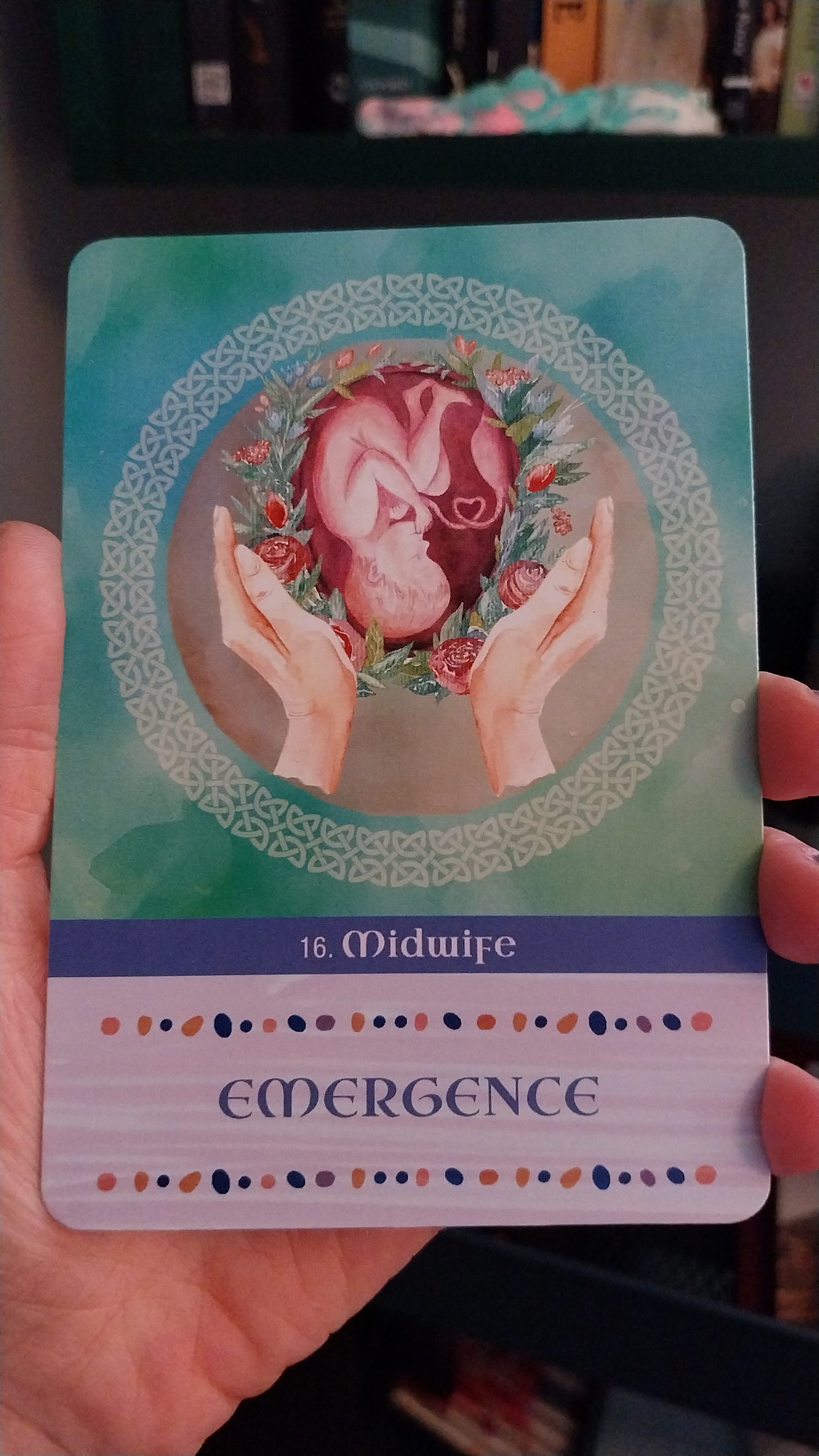Hello lovelies,
For our first Creative Ancestor Profile, it is Brigid who has come forth. We are still in her time, the season on Imbolg or Imbolc, which means “in the belly” in Old Irish and is thought to refer to the pregnancy of ewes during this time. A season of fertile possibilities.
I opened the space to write by lighting Brigid’s candle and inviting guidance from Brigid herself through the gorgeous Brigid: Celtic Goddess & Matron Saint of Ireland oracle by Dr. Karen Ward and Bernie Sexton of Moon Mná. The card I pulled for you reading these words, for our community is:
Midwife - Emergence
You are fertile with new, exciting ideas. Some aspect of your life is stuck and needs to be released. Time to be reborn! You are ready to emerge from your chrysalis.
Brigid is one of the most well-known of the Celtic goddesses with Indo-European roots. She goes by many names like Bríd (“Breej”) in Ireland, Bride in Scotland, Brigantia in Britain, and even has nicknames in Ireland like Biddy or Bridie she is so ingrained in folk memory and culture. Her name means “High One” or “Exalted One”.
Creative Ancestor
There is much to say about Brigid, many books have been written about her in both her goddess and saintly forms. Today, I will write intuitively and focus on her as a Creative Ancestor. The reason I use the term Creative Ancestor is because I believe that when we invite our ancestors into our creativity, we radically enhance our well-being as this supports two fundamental human needs; the need to belong and the need to create.
The ancient Irish curated their tuatha, their tribes around creativity, with the Áes Dána, the “People of the Arts” as their leaders. Today, inspired by this, the Irish Arts Council’s Aosdána (modern spelling of Áes Dána) honours artists whose work has made an outstanding contribution to the creative arts in Ireland.
The Áes Dána co-existed with the Otherworld, which could be accessed through the psyche or soul, and the land. Nature, along with storytelling, dream-work, imagination, and their bodies, helped the Áes Dána to open this portal so that the wisdom of the old deities like Brigid who were, in essence, their Creative Ancestors, could flow through in service to their creative expression and their community.
My recent story of Fedelm The Prophetess is a weaving of myths about the Áes Dána.
If you desire, have your pen and journal at the ready for some journalling prompts provided at the end of our Brigid explorations.
Brigid - Tribal Daughter


Brigid is born a goddess of the Tuatha Dé Danann, “Tribe of the Goddess Danu”, Ireland’s supernatural race. Her father is the Dagda, the Fer Benn, the peaked or horned man. He is said to be the “Father of All” and is a nourishing provider god with his cauldron of plenty that never runs dry.
Brigid’s mother is unknown. Two powerful goddesses who take the Dagda as a lover are Bóinn and the Morrigan. Bóinn means “White” or “Fair Cow” like Hathor in her celestial white cow form in Egyptian mythology, Bóinn is associated with the Milky Way, she is also the River Boyne that runs through Brú na Bóinne, the “Mansion” or “Womb of the White Cow” the Irish name for Newgrange. The Morrigan is a potent expression of the dark feminine in Irish mythology who can shapeshift into a white cow with red ears.
Brigid herself is said to only take milk from a white cow with red ears. In her later, saintly form, she travels from homestead to homestead accompanied by her red-eared white heifer, and so it’s plausible that Bóinn or the Morrigan could be her mother. Regardless these three goddesses all hold that Great Mother energy symbolised by the cosmic cow.
Brigid - Sacred Keener
Brigid marries Bres who becomes the High King of the Gods of Ireland. Due to Bres’s scabbiness, which is a taboo in Irish mythology and to this day in Irish culture, war breaks out in which their son, Rúadán is killed. In response, Brigid is said to be the first woman to keen in Ireland, “Then for the first time weeping and shrieking were heard in Ireland”.1
Keen is an anglicisation of Caoin (sounds like “Queen”), the Gaelic verb to cry or lament. From Brigid’s time onwards, this is a role held by a woman, the Bean Chaointe, the “Keening Woman”, an integral part of the community and central to the Irish wake to help the soul pass over.
When Brigid keens for Rúadán, it’s said that she, “invented a whistle for signalling at night”.2 This is one of my favourite expressions from Irish mythology, I find it profoundly beautiful. This sacred sound is a guiding signal to the soul of the person who has passed, who is being keened for, to help them travel from this world, westwards into the night of the eternal Otherworld.
This deeply moving keen is one for hunger in memory of the (at least) one million Irish people who died during the Gorta Mór, the Great Famine. It’s by Donnacha Dennehy, Katherine Manley and Iarla Ó Lionáird.





